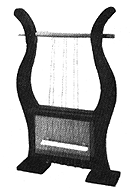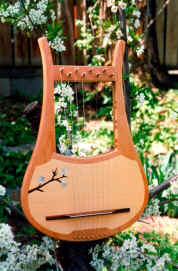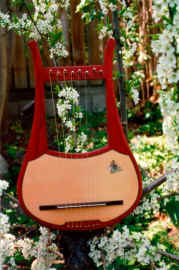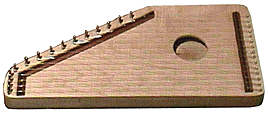Lyres - King David's Harp
 The earliest example of the lyre was found in Sumerian
The earliest example of the lyre was found in Sumerian
art works dated 2800 BC. Sumerian lyres were assymetrical,
with one "arm" longer than the other, often adorned with
the sculptured figure of a bull or bulls head at the joint of
the sound box and one of the arms, with 9-11
strings. The Egyptian lyre first appears around 2000 BC, with curved or
straight arms of different lengths. It was played with a long plectrum held
in the right hand, all strings being plucked together, while the left hand
fingers fanned out to silence the unwanted ones. As a rule it was held
horizontally with the crossbar away from the player. After 1000 BC a smaller,
symmetrical lyre came to Egypt from Asia, with parallel arms, held upright.
The lyre was also known to the ancient Hebrews, a trapezoid with 3-12 sheep
gut strings of different thicknesses. Recent investigation suggests it may not have
been tuned pentatonically, but diatonically with microtones. In Greece the lyre
was referred to as the phorminx and kitharis. The tuning was pentatonic without
semitones, for instance EGABD, not neccesarily in that order, with any extra strings
duplicating those notes in other octaves. The F, C and other notes were obtained by
stopping the next lower string to raise its pitch. Lyres have spread to Britain, France,
Germany, Scandinavia, Finland, Estonia. As time progressed the lyre was not only
plucked but bowed. The plucked lyre did not survive the Middle Ages in Europe, while
the bowed lyre survived only in Wales as the Crwth. Plucked lyres are still played in
Asia and East Africa, in Ethiopia, the Upper Nile, and the Congo.
[ information excerpt from Lark in the Morning : http://www/larkinam.com ]
![]()
Ethiopian Lyre
The Kissar, known as the Kisirka, or Ethiopian lyre, is the parent of the cithara
and lyre. In the very fine examples belonging to the late Mr. T. W. Taphouse, M.A.,
of Oxford, the strings are of camel gut. The Kissar was plucked with the fingers,
or else with a horn plectrum, and as in the case of the harp, there was much diversity
in regard to the number of strings - the general number number being seven. (Although
there is a specimen in Berlin having thirteen strings)
[Excerpt taken from : The Story of the Harp by W.H. Gratten Flood. Walter Scott Pub. 1905]
![]()
EVD INSTRUMENTS
So often seen in Renaissance paintings are depictions of angels with Lyres in the arms.
Luthier and Guitar-maker Edward V. Dick has taken those images and created what he
sees in the paintings. With his wonderful inventiveness and craftmanship, construction
of modern acoustics has assisted him to dimiss the crude primitive nature of the
instrument.


made by
Luthier and Guitar-maker Edward V. Dick @ EVD String Instruments
[ http://www.musicore.com/evd/lyre.html ]
![]()
Plucked Psaltey and Zither
As all the earlier examples shown here, the Psaltery and Zither have fixed
pitches. The major difference is string length. A lyre, in most cases,
is often thought of as having quadragular frame with string length being equal.
Therefore, string tension and gauge (at least what we now know it as today) would
most likely be the cause of pitches. Here on the psaltery and zither, in addition to
tension and gauge, length is the main cause.

![]()